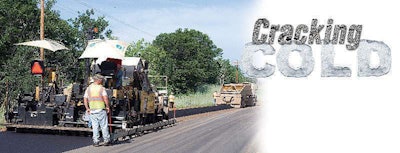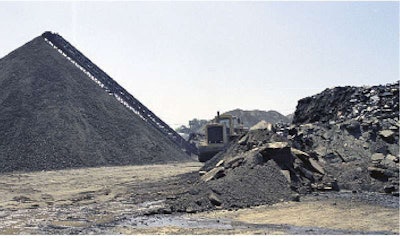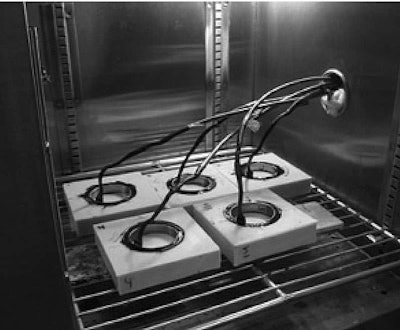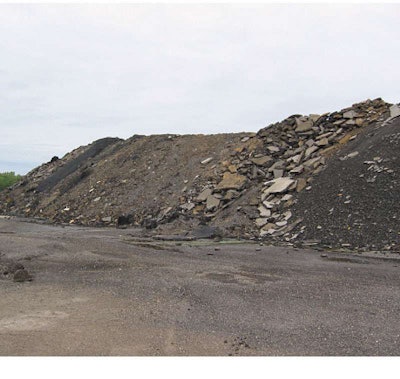 Crow Wing County, Minn., is fighting low-temperature cracking of virgin and RAP mixes by using a warm-mix asphalt additive.
Crow Wing County, Minn., is fighting low-temperature cracking of virgin and RAP mixes by using a warm-mix asphalt additive.Solving the Riddle of RAP and Thermal Cracking
By Tom Kuennen, Contributing Editor
Use of reclaimed asphalt pavement (RAP) in hot-, warm- and cold-mix asphalt is growing dramatically, as tests validate its use in ever-increasing quantities.
But there are fears that higher quantities of RAP may compromise mix performance in cold-weather regions. There, where pavement temperatures plunge during the long winters, “thermal” cracking – also widely known as low-temperature cracking – compromises longevity of asphalt pavements.
Prolonged frigid temperatures can cause asphalt pavements to crack if the wrong asphalt binder is used for the climate, or if the binder has “aged” prematurely via excessive heat in the plant where it was made. That can lead to premature deterioration of a roadway and create the need for costly, congestion-causing repairs.
 Low-temperature cracking (transverse cracks) may occur when asphalt pavements contract in cold temperatures
Low-temperature cracking (transverse cracks) may occur when asphalt pavements contract in cold temperaturesAs the percentages of RAP in asphalt mixes grow, RAP has come under scrutiny as a contributor to low-temperature cracking. While use of 15 percent or more RAP can result in a significant increase in mixture stiffness, which can enhance durability, that same stiffness can negatively affect low-temperature cracking characteristics of the pavement.
But the public and private sector are working diligently to overcome these negatives.
What is Low-Temperature Cracking?
This distress is manifested as a series of transverse cracks that extend across the pavement surface in response to cold temperatures. Thermal crack intervals of 19 to 30 feet are typical, but may vary widely. Spacing of cracks often is regular over the length of a pavement.
Thermal cracking in flexible pavements can exacerbate heaving of expansive soil subgrades, causing large cracks that are subject to movement and even faulting of pavements from one side of the crack to the other. In Wichita, Kan., for example, a generation of pavements was plagued by thermal crack-driven fissures so big they could swallow a beer can. There, these expansive bases were stabilized by chemical treatments like pebble lime, soil cement or fly ash, or a mixture of those, which gave excellent bearing values, but were compromised by asphalt thermal cracking, due to climatic variations and freeze/thaw cycles.
 Residual asphalt in reclaimed asphalt pavement (RAP) can stiffen asphalt mix, enhancing durability, but also can contribute to low-temperature cracking.
Residual asphalt in reclaimed asphalt pavement (RAP) can stiffen asphalt mix, enhancing durability, but also can contribute to low-temperature cracking.Extreme cold triggers the most common type of distress of asphalt pavements, low-temperature cracking, says a technical brief – Investigation of Low-Temperature Cracking in Asphalt Pavements – published in 2008 by the Minnesota DOT (MnDOT).
“As temperatures drop, the pavement contracts, building up tensile stresses that lead to cracking,” states MnDOT’s Research Services Section. “Fractures occur every 20 to 30 feet across the lane, allowing water to penetrate the structure, which further weakens the pavement layer and the base beneath. Traffic loads worsen these cracks, leading to shorter pavement life, increased maintenance requirements and rougher roads.”
MnDOT attempts to limit asphalt pavement cracking by specifying Superpave performance-graded asphalt binders that have favorable properties at very low temperatures, the tech brief says. “However, more factors contribute to cracking than just the binder. The various aggregates that make up more than 90 percent (by weight) of a typical asphalt mix may each respond differently to low temperatures,” it says. “Crude oils from different geographic locations produce asphalt binders that interact differently with aggregates, and asphalt binder grades and contents can also vary from mix to mix.”
Complicating characterization of aggregates to fight thermal cracking is the increasing use of RAP and its residual asphalt binder as aggregate in mixes.
Challenge of RAP Aggregate
The use of RAP in recycled asphalt pavement is well accepted at the state, city and county levels. Almost all hot-mix asphalt (HMA) contains at least some RAP in many areas. But the RAP that can be added to hot-plant mix asphalt mixtures is limited to relatively low percentages and, in some areas, the use of RAP is prohibited in certain types of mixtures, such as surface courses. Typically, the maximum percentage of RAP allowed is anywhere from 15 to 30 percent by weight of HMA mixture.
 Thermal crack intervals of 19 to 30 feet are typical, but may vary widely.
Thermal crack intervals of 19 to 30 feet are typical, but may vary widely.Yet, recent investigations show HMA materials with percentages in excess of 50 percent can be produced to perform to the same as “virgin” mixes. Agencies that are not currently allowing RAP into their HMA mixtures — and those that are only allowing small percentages of RAP — can safely increase the amount of RAP used without fear of shortening pavement life, provided that best practices are followed, according to a Federal Highway Administration (FHWA) Tech Brief titled High Reclaimed Asphalt Pavement Use.
As reported in Better Roads late last year, government agencies from coast to coast are trying to determine how to increase the percentage of RAP used in intermediate and friction (surface) courses (see “How Much RAP?,” November 2011, pp. 21-31).
 With the new Asphalt Binder Cracking Device (ABCD), asphalt binder is poured around the rings, then cooled to a very low temperature in a controlled manner.
With the new Asphalt Binder Cracking Device (ABCD), asphalt binder is poured around the rings, then cooled to a very low temperature in a controlled manner.The aggregate in RAP should be considered as if it were just another stockpile of virgin aggregate, the Washington State DOT (WSDOT) says. As with virgin aggregate properties, RAP aggregate properties — foremost among them residual asphalt clinging to the aggregate particles — may limit the amount of RAP that can be used in a particular mixture.
RAP asphalt binder will blend with virgin asphalt binder in most any mix design, and the resulting properties of this blended asphalt binder must be understood, the state says. But the effect of RAP residual asphalt binder must be considered when using RAP in Superpave or any mix design, because RAP asphalt binder already is significantly aged because of its previous field life.
“This aged binder is generally stiffer than virgin asphalt binder and thus will cause the resultant binder blend to become more viscous (stiffer),” WSDOT says. “This, in turn, will cause the HMA to be more viscous (stiffer).”
As a result, successful RAP mix designs incorporating RAP above 15 percent by weight should analyze the stiffness of the existing residual binder in the RAP, and compare it to the stiffness of the virgin liquid binder, along with the proportions of each in the final product.
New Research
As the use of RAP in mixes isn’t going to decline, vigorous research now is under way to reconcile higher percentages of RAP with the danger of stiffness-induced low-temperature cracking.
In December 2011, FHWA’s Office of Pavement Technology and Office of Infrastructure R&D at the Turner-Fairbank Highway Research Center released an important study, Investigation of Low- and High-Temperature Properties of Plant-Produced RAP Mixtures (FHWA-HRT-11-058). Written by Rebecca S. McDaniel, Ayesha Shah and Gerald Huber, this new study analyzes the results of testing plant-produced, hot-mix asphalt containing various levels of RAP and different grades of virgin binder, undertaken initially to examine the effects of RAP on low-temperature properties of mixtures.
For this work, FHWA — in conjunction with the North Central Superpave Center and Heritage Research Group — is investigating and evaluating plant-produced HMA mixtures containing varying percentages of RAP.
“So far, results appear to confirm the current suggested guideline for the use of RAP in the amount of 15 percent or less that states that ‘no change is required in the binder Performance Grade (PG) or in the mixture design,’” the researchers said in December. “However, in the case when higher amounts of RAP (i.e., greater than 25 percent) are used, the stiffness properties of the mixture increase (significantly in some cases) and it may be necessary to lower the PG of the binder or use blending charts to [either] determine the amount of RAP to use based on the virgin binder grade or determine the virgin binder grade, and amount based on the desired amount of RAP.”
The results highlight some challenges in using high amounts of RAP. “A primary concern is the performance of high-RAP mixtures in cold climates,” they say. “The addition of high amounts of RAP to an HMA mixture usually increases the mixture’s stiffness. In cold climates, this may contribute to the occurrence of low-temperature cracking. Another concern is due to the uncertainty of what occurs between the virgin and the RAP binder during mixing in a HMA plant.”
Current activities include expanding to include materials from multiple HMA suppliers in order to get insight on producing HMA mixtures with RAP, and to substantiate the results of the original project now referred to as Phase I.
Among other conclusions, the researchers found:
• Test results on binders extracted and recovered from the plant-produced mixes show that, in general, as the RAP content in the mixture increases, the high-temperature grade of the recovered binder also increases, but only by a few degrees (33.8 to 37.4 °F).
• As the RAP content increases, the low-temperature grade of the recovered RAP binders also increases, but not as much as the high-temperature grade.
• The use of a softer virgin binder grade typically decreases both the high- and low-temperature grades of the recovered binders by half a grade or more.
• Increasing the RAP content to 25 percent changes the recovered binder low-temperature grade by no more than 35.6 degrees F, compared to the binder recovered from the virgin mix (with no RAP).
• RAP content can possibly be increased to 25 percent before changing the virgin binder grade, but a grade change should be incorporated when increasing the RAP content to 40 percent. The findings are considered representative of mixtures produced in hot-mix plants in Indiana using virgin asphalt binders and RAP typically found in Indiana (see the November 2011 Road Science for more on Indiana and RAP).
• And other agencies should review their typical materials, especially RAP stockpiles, to determine their own course of action.
WMA Quells RAP Cracking?
Counties as well as states are active in studying RAP and thermal cracking. In central Minnesota in 2009, Crow Wing County used a warm-mix asphalt (WMA) additive — Evotherm from MWV Asphalt Innovations — to see if it could get from a lower-cost PG 58-28 binder the same cold-weather performance of the more expensive polymer-modified PG 58-34 binder specified in Minnesota for newly constructed low-volume bituminous roadways. One of its mixes used 30-percent RAP.
It also hopes to use the WMA additive to improve binder durability by reducing the premature or “artificial” aging to binder caused by exposure to the scorching heat of the asphalt plant burner.
In 2009, Crow Wing County was in the second year of testing of WMA to ameliorate thermal cracking and improve binder durability. Following a test project in late 2008, testing in 2009 included placement of two layers of bituminous mix containing a warm-mix additive, and 30-percent reclaimed asphalt pavement, on County Road 2.
“One of the hoped-for benefits of warm-mix asphalt is greater durability over time,” says Wayne Dosh, senior engineering technician, Crow Wing County Highway Department. “One of the issues we struggle with in Minnesota is thermal cracking. It’s usually the biggest killer of our roads. One of the ways to get around it is by using ‘softer’ grades of binder. The performance-grade binders used are based on our ambient temperature extremes, and with that kind of spread, that usually implies polymer modified asphalt. By using a warm-mix additive, we hope to be able to get the same performance with a non-modified oil as with a modified.”
But premature aging of binder also is an issue that the county hopes to minimize with warm-mix asphalt. “One of the benefits of warm-mix over hot mix is that in the hot-mix plant, the heat contributes to premature or artificial aging of the binder, which breaks down the oils,” Dosh says. “This gets even worse as the mix ages in-place over time. One of the benefits we’re hoping from the warm-mix additive for is for us to be able to use cheaper binder – PG 58-28, that doesn’t require a polymer modifier – with the added benefit of less premature aging in addition to less thermal cracking.”
The result has been a success. In a June 2011 WMA webinar, Dosh said the initial rate of oxidation is less for WMA, which should result in longer service life and a slower binder aging process. “Crow Wing County plans to place an additional 3,500 tons of WMA this summer,” Dosh said in June.
PG Binders, CIR Help
Low-temperature cracking proved to be the No. 1 cause of transverse cracks in the vicinity of Ottawa, Ont., but use of appropriate PG binders and cold-in-place recycling helps fight it, according to Low Temperature Cracking Performance of Superpave and Cold In-Place Recycled Pavements in Ottawa-Carleton, by Stephen Q. S. Lee, P. Eng., Anita VanBarnefeld and Michael A. Corbett, P. Eng., Environment and Transportation Department, Regional Municipality of Ottawa-Carleton in Canada.
Historically, the Regional Municipality of Ottawa-Carleton (RMOC) used 85/100 PG binder with typical 58-22 in all conventional hot-asphalt mixes, the authors wrote in 2000. “The low pavement temperature extreme encountered during any given winter in Ottawa-Carleton is generally below minus-26 degrees C (minus-14 degrees F). This has resulted in a high frequency of low-temperature cracking (transverse cracking).”
To mitigate low-temperature cracking, the RMOC was using Superpave PG 58-34 asphalt mixes and the cold-in-place recycling process to mitigate the low-temperature cracking problem. To assess the cost-effectiveness of these pavement alternatives to conventional hotmix, a network-wide evaluation and correlation of costing, performance, serviceability and lifecycle were carried out. A total of 38 regional arterial roads were analyzed, further dynamically sectioned by asphalt type, last rehabilitation method, asphalt age, asphalt thickness, subgrade type and drainage condition.
“[L]imited data on Superpave PG mixes indicated significantly improved initial low-temperature cracking performance and a substantial lifecycle cost advantage when compared to conventional candidates,” they wrote. Cold In-Place Recyling (CIR) rehabilitated candidates “indicate better low-temperature cracking performance than both resurfaced and reconstructed candidates using conventional hot mixes.”
MnDOT Research
MnDOT’s Minnesota Road Research Facility (MnROAD) is conducting a five-year project to study the performance of RAP and determine if the present specified limits on RAP are justified.
Under the project – Cold Climate Performance of RAP under Controlled Testing Conditions – several asphalt concrete test sections will be built and contain 30-percent RAP, but vary in binder grade and fractionated RAP content. It is anticipated that the results of this research will lead to the modification of current specifications to include fractionation of RAP aggregate and/or new percentage requirements for high-RAP asphalt.
 A stockpile of RAP from a variety of sources.
A stockpile of RAP from a variety of sources.Separately, the Minnesota 10-state-pooled fund study – Investigation of Low-Temperature Cracking in Asphalt Pavements – began with a literature search to identify potential test methods and modeling approaches. It then undertook field investigation of 13 HMA pavement sites, documenting performance (good vs. poor), mix properties and traffic, and taking samples (both cores and beams) for laboratory testing.
“Investigators found that standard specifications do not include a specific test for measuring the potential fracture behavior of mixtures,” the tech brief states. “Another key finding was that asphalt binder testing alone does not reliably predict low-temperature cracking. Mixture testing revealed that aggregate type affected resistance to fracture (granite outperformed limestone), as did the use of asphalt binders modified with polymers (modified PG 64-34 binders outperformed PG 58-34 binders).”
New Test for Crack Potential
Also, new devices are making evaluation of low-temperature cracking more predictable. In December 2010, FHWA’s Highways for Life initiative reported that an inter-laboratory study – conducted with the help of an FHWA grant – confirmed the accuracy and usability of a device to pinpoint the temperature at which asphalt binder will crack.
The Asphalt Binder Cracking Device, or ABCD, uses a simple method to determine the susceptibility of various binders to thermal cracking before they are used on paving projects. Highways for Life provided a grant under its Technology Partnership program to help EZ Asphalt Technology of Athens, Ohio, develop and evaluate the ABCD.
The first phase of testing involved conducting a field validation of the ABCD and refining the equipment and analysis software. In the second phase, 31 laboratories participated in a study to evaluate the repeatability, accuracy and simplicity of the testing system.
Unlike conventional test methods, the ABCD creates thermal cracking conditions similar to those in the field. It consists of a metal ring equipped with temperature and strain gauges that fit into a silicone mold. Heated asphalt binder is poured around the ring and the device is cooled.
As the temperature falls, the asphalt binder contracts more than the metal ring, causing the binder to fracture. A computerized data acquisition system captures the temperature and stress level at which the fracture occurs. That information can be used to grade asphalt binders for expected climate conditions, as well as to develop new binders that can better withstand cold temperatures.
The American Association of State Highway and Transportation Officials is reviewing the ABCD test procedure and considering making it a provisional standard, the first step toward final adoption as a standard.












